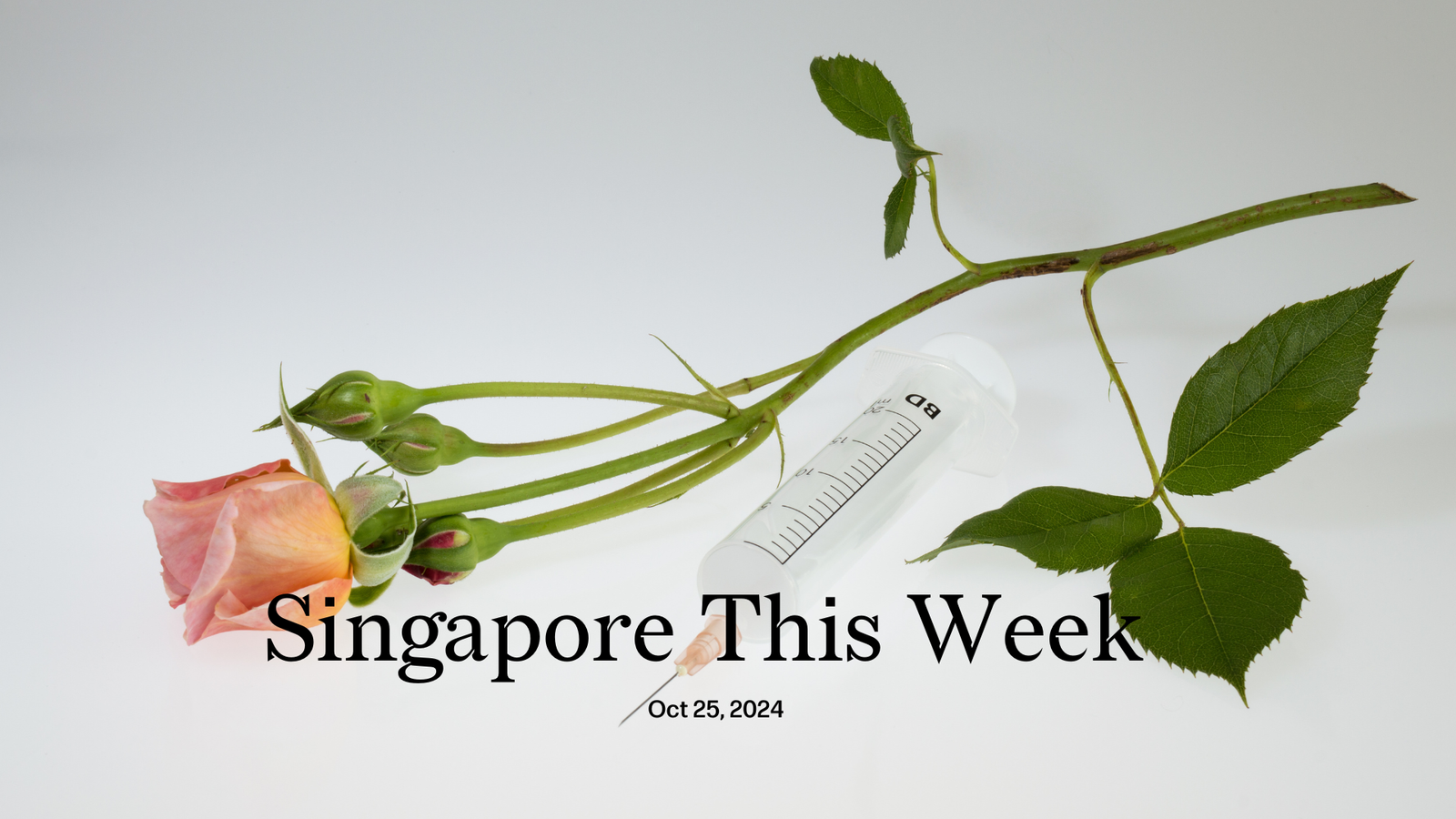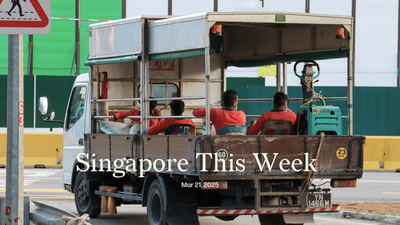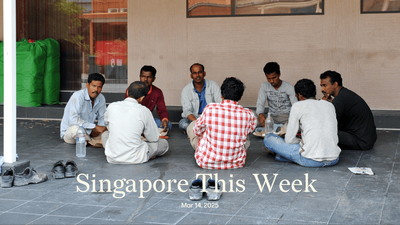Politics: London Calling
We should, for a moment, forget the house and forget the Lees, forget the polished proclamations that still do tease. Consider that another has granted political asylum to one of our own. A son of the first prime minister has fled the country his father helped build. And, like exiles before, he’s found solace with the former colonialists his father helped banish.
We know what the apologists will say. They’ll preach about how rich and happy all Singaporeans apparently are. They’ll thump their chests with nationalist bravado. They’ll scream neo-colonialism, and tell the Brits to butt out. And, as The Straits Times (ST) did, they’ll relegate this news that’s dominating global headlines to a small column at the bottom of the front page. Not our dai-ji.
Except, it is. The granting of asylum is not an impetuous jibe, but the product of an exhaustive two-year process by a defence partner. Not that our country would know. Singapore has still not signed the 1951 Refugee Convention, turned away the Vietnamese “boat people” fleeing a war we supported, and had trouble helping the Rohingya but less trouble facilitating the junta’s arms trade.
The Financial Times cited UN data showing “a marked rise in the number of Singapore nationals seeking asylum elsewhere”. Who are these people??? We now know of one. Democracy here is like Schrödinger’s cat, dead or alive, depending on when you look. This week, better don’t look lah.
Society: Live, or Let Die?
Alverna Cher Sheue Pin has been sentenced to more than six years in prison for abetting her ex-boyfriend’s suicide. He was in acute financial distress, and had made up his mind to die. Shawn Ho, district judge, told Cher: “The offence of abetting suicide clearly signals society’s opposition to suicide. Life is sacred.” Is death sacred too?
A libertarian may argue that it is, in that individual freedom is sacrosanct. A person wishing to die should be allowed to do so no matter their rationale; and the state should not punish anyone who helps them. Of course, no society allows that, nor is there much evidence to suggest any ever did. However, euthanasia, in which a medical practitioner gives a terminally-ill patient a life-ending drug, and doctor-assisted suicide, in which a doctor provides a prescription for the patient to administer the drug themselves, are both on the rise. In the last decade, at least six countries as well as numerous states in the US have legalised some form of assisted dying. The UK’s parliament is currently discussing a bill to do the same.
Here, as elsewhere, opposition is along two broad lines. The religious denounce this violation of life’s sanctity. Another worry is that the emotionally, physically, and economically vulnerable could convince themselves, or be nudged by the unscrupulous, into taking the final step. For the latter, movies like the Japanese-language “Plan 75”—in which a government programme, complete with unctuous sales reps, allows anyone 75 years or older to voluntarily kill themselves—show the logical and terrifying endpoint of legally assisted dying. The focus instead should be on better treatments and better palliative care for those with serious chronic or terminal illness.
Proponents claim that there is now enough data to alleviate such worries. The Netherlands and Belgium—incidentally with some of the least religious societies in the world—have had the most liberal assisted dying laws since 2002. Their experience shows it is possible to design a system that allows the incurably suffering to go when they choose, and protects those who’re susceptible to coercion of any kind. In The Netherlands, for instance, doctors failed to follow some of the “due care criteria” in four of the 6,361, or 0.06 percent, assisted deaths in 2019. None of those stemmed from malice or manipulation, or resulted in unwanted deaths. Assisted dying is an ethical, social, political, emotional, religious, philosophical morass. Dignity in death, as in life, has to be the goal. How we get there: ay, there’s the rub.
Society: The hangman
It’s been a busy year on the frontlines of Singapore’s war on drugs, and the commitment of K Shanmugam, the country’s drug czar, remains unwavering. In a BBC two-part podcast and a CNN video, the home affairs and law minister once again extolled the virtues of the city-state’s punitive drug policies and warned of potential chaos if the state eased up on its zero tolerance stance on drug offenders. “You look around the world, any time there’s been a certain laxity in the approach to drugs, homicides go up,” he told CNN, calling drugs an “existential threat” to Singapore’s social fabric. Shanmugam furthers his case for the supposed deterrent effect of the death penalty, noting to the BBC that the government has “absolutely clear evidence” that it saves more lives than it takes away, while “substantially” reducing drugs being trafficked into Singapore. It’s nothing we haven’t heard before, ad nauseam—explanations leading to the same reasons why the death penalty must remain on the books, and why calls to impose life sentences instead have been rejected. Shanmugam is, however, open to being convinced otherwise. (We wonder: has he read this?)
Perhaps telling is an inmate’s response to CNN’s Ivan Watson when asked whether the threat of the death penalty had deterred him from selling methamphetamine, the same drug he was addicted to: “At that point of time I wasn’t thinking about it…I was actively avoiding the whole issue of consequences.” BBC journalist Linda Pressly shared this observation with Shanmugam: “[O]ften it’s drug users of many years…who are being convicted on capital charges here…[W]e could probably agree that if you’ve been using heroin for 50 years, you’re not actually going to be doing rational thinking very well.” But “Shan” wasn’t dissuaded: “If there is that perception, people know that it's serious, and people believe that it is more of a deterrent, then many more who would be drug traffickers will be deterred.”
Open to being convinced, but apparently not yet by such evidence, testimony, and logic. “You put a life sentence at least I can see my brother every now and then,” Nazira Lajim, whose brother Nazeri was executed in 2022, told the BBC. “Nobody can take one’s life except for God.”
History weekly by Faris Joraimi
Khir Johari triumphs again: his lush volume, The Food of Singapore Malays: Gastronomic Travels through the Archipelago has won the National University of Singapore (NUS) Singapore History Prize. (Disclosure: Khir’s a friend, and I wrote the book’s afterword.) The winner of the triennial award is decided by a distinguished jury panel chaired by former diplomat Kishore Mahbubani. The other members were historians John Miksic and Tan Tai Yong (NUS), Peter Coclanis (University of North Carolina) and economist Lam San Ling (SMU). Many people are named in Khir’s long and moving acknowledgements, but the vision—its ambition and heft—is entirely his. If you haven’t read or heard of the book, the jury’s full written citation helpfully summarises its contents and significance. Most importantly, it highlights Singapore’s historical connections to the Malay Archipelago that pre-date Raffles, through the unconventional lens of food. Sadly, most (but not all) academic historians probably don’t consider cuisine a worthy or “serious” subject, and it was long considered the pursuit of dilettantes, gentlemen-amateurs and housewives. But Khir takes food and eating seriously, giving us a valuable framework of how people and space combine in regional history.
From the first chapter, the book foregrounds space as the most important factor that makes “the Malays” a coherent and meaningful idea: that they belong to a geography, that it has a particular environmental composition and patterns of movement. Beyond language, dress or religion, it is this continuous relationship with space and its products and resources—foraging, trading, cultivating, fermenting, and digesting—that allows us to speak of its diverse groups as “Malays” and this inhabited geography, a “Malay world”. A lot of people are anxious about the “M”-word, from Indonesian chauvinists to Singaporean nationalists. But unlike the program offered by UMNO (and its many offspring), Malayness was historically an expansive project, rather than that which submerges and homogenises. Race, a concept too narrow, rigid and modern to encompass the complexity of being Malay, disappears from Khir’s tender pages. In our age of resurgent ethno-religious nationalism, this message is timely. The book adds to historians’ work showing how space is made by practice and knowledge. For Khir, it seems to be that what makes this a Malay world is that across the archipelago, people will know how to ferment shrimp, use coconut cream, and make sambals, as much as they know how to cakap Melayu and tie a sarong. By the time we reach the chapter dedicated to the Peranakans (in their many manifestations), this also becomes an intrinsically feminist history: local women kept the culinary arts alive, and domesticated waves of outsiders, making them participate in the shared project of becoming local, or peranakan negeri. Amidst today’s vexed debates over “identity”, Khir guides us through a living tradition where such a thing may not be a reliable way to understand ourselves and each other. By cooking and eating, practising and learning, we are changed, and brought into a relationship with space. Congratulations, Khir.
Arts: Joel Tan holds Court
A repatriation play by Joel Tan, himself an expatriate to London, has copped a coveted spot in the Royal Court Theatre’s upcoming season. The storied red-brick theatre, occupying a corner of the cultural capital’s upscale Sloane Square, is best known for discovering new writing and catapulting its stable of writers into the spotlight. Tan has been appointed its Jerwood New Playwright and his play, “Scenes From a Repatriation”, will premiere next April in the theatre’s intimate 90-seater studio. The polyphonic play revolves around a 1,000-year-old statue of the Bodhisattva Guan Yin in the British Museum, and what transpires when it’s revealed that the artefact was stolen—reflecting very real restitution controversies that museums built on colonial plunder are facing today. David Byrne, the Royal Court’s artistic director, told The Guardian that this “internationalist” season is “a combination of the best stuff I’ve seen over the last year and the most urgent bits of writing that need to be heard from our stages right now, things from our recent past to glimpses of what our future could be”. It’s the first time in years that a Singaporean has treaded this theatre’s boards. In 1992, thespian Chay Yew packed the seats with “Porcelain”, a harrowing exploration of a Chinese teen’s crime of passion when he’s found in a public bathroom with his dead lover’s body.
Tan, who moves between Singapore and London, has frequently tackled challenging political fare with a fierce wit and delicate lyricism. “No Particular Order”, which was staged both in the UK and Singapore, strings together a series of interconnected vignettes in an apocalyptic world, where characters navigate a war-torn alt-universe with humour, rage and tenderness. His work also plumbs the fraught emotional depths of moral panic, power asymmetries and queer anxieties. “G*d Is A Woman”, the critically-acclaimed satire, skewers complaint culture and moral outrage in a parodic version of Singapore, and claimed a clutch of prizes, including best script, at this year’s ST Life Theatre Awards. The Royal Court’s getting him as he’s coming into his own, when he’s building worlds that are just slightly askew: far enough to be nudge-wink tongue-in-cheek, near enough to hit just a little too close to home.
Arts: “You’re hired!”
Apprentices, get those CVs ready. The University of the Arts Singapore is teeing up paid internships and prospective jobs for a select dozen of their new students under an inaugural industry partnership with Arts House Limited. The state-adjacent non-profit organises both the Singapore International Festival of Arts and the Singapore Writers Festival, alongside managing six arts spaces, including the Victoria Concert Hall and Goodman Arts Centre. The work experience programme promises a 10-week stint for bachelor’s and master’s students from LASALLE College of the Arts and Nanyang Academy of Fine Arts, the two institutions that constitute the new private university. Students will get a monthly allowance starting at S$800 and try their hand at everything from venue management to developing marketing campaigns for next year’s writers festival.
The Singapore arts industry relies heavily on gig workers, who often face relentless financial precarity and high-stress environments. Unpaid internships, while frowned upon, still exist, where under-resourced organisations may persuade fresh grads or final-year students to pick “exposure” over remuneration. This recent slate of bridging programmes offering a financial baseline, even if low-wage, isn’t just the remit of statutory boards and government agencies; more arts groups have been tailoring paid professional training schemes to early-career arts workers. These include the first-ever Emerging Producers Programme by community network Producers SG, and arts management company The Backstage Affair’s Apprenticeship Programme, catering specifically to aspiring production and stage managers, the invisible backbone of the performing arts sector. On-the-job training is crucial because every project—from a theatre production in a traditional venue to a public art walking tour—demands a different skill set and a formidable adaptability. The Backstage Affair, whose entry-level and intermediate apprenticeships are currently open for applications and offer at least S$1,100 a month, makes no bones about the challenges of the sector. “[H]ours will be long and irregular,” goes the FAQ, but participants “will get first-hand experience of the intricacies and hard work that goes on behind the scenes, and learn to find creative solutions for any challenges that come your way.” A reputation for competence and a commitment to relationship-building go a long way in the close-knit sector, where long-term connections and repeat contracts are forged in the crucible of “the show must go on”. A well-structured apprenticeship is one more insulated way of getting past that fiery threshold.
Business: Is ONE Championship still in the ring?
Singapore-based ONE Championship is the world’s fourth most valuable combat sports promoter. You may have seen one of its MMA fights on Channel 5 or a live event at the Singapore Indoor Stadium—the first was in 2011. Since then, ONE Championship has held over 200 events across Asia, raising US$500m (S$674.5m) from investors such as GIC, Temasek and Sequoia Capital in the process.
In 2022, the company’s losses narrowed to US$61.7m (S$81.6m) from US$111m (S$146.7m) the previous year, with revenue hitting US$84.5m (S$111.7m). This year, Forbes valued it at US$1.3bn (S$1.7bn). Yet, current market conditions have forced ONE Championship into laying off “a few dozen” employees worldwide, with the Singapore workforce reportedly the most affected. The company’s CEO, Chatri Sityodtong, announced the decision in an internal email, citing record revenues and strong viewership numbers, but also acknowledging the challenging global macroeconomic environment and pressure from capital markets for immediate profitability.
ONE Championship has also been adapting its business strategy, focusing on lower-cost markets for live events and expanding into new territories like the US and Middle East. After enduring these recent layoff punches though, one wonders if they are still in the ring for the IPO they’ve been planning since 2022.
Tech: eFishery not going public anytime soon
Founded in Bandung in 2013, eFishery is an aquaculture firm that serves the fishery supply chain. This includes auto-feeding systems, and marketplaces where farmers can, among other things, buy fish and shrimp feed, and later sell their fresh produce. Today it serves some 70,000 farmers in 280 cities across Indonesia. It’s one of South-east Asia’s startup darlings, supported by leading venture capital firms such as Peak XV (formerly Sequoia Southeast Asia & India), Wavemaker Partners, Northstar, Temasek and Softbank. After its gargantuan US$200m (S$263.9m) Series D last year which took its valuation to over US$1bn (S$1.3bn), there were naturally questions around when the company would go public.
Yet, on the first day of the Tech in Asia conference in Jakarta, CEO Gibran Huzaifah shared that eFishery is in no hurry, instead focusing on financial health and operational stability while waiting for more favourable market conditions. Since launching in 2013, the company has demonstrated strong growth, become profitable, expanded into India, and now plans are afoot to strengthen its supply chain, increase market penetration, and expand into new export markets over the next five years, including China, Japan, South Korea, and the Middle East. While eFishery takes a measured approach to going public, its success has likely been an inspiration for numerous other agritech and aquatech startups with similar business models such as Aruna, Jala, BroilerX and Eratani. Will these venture-backed companies be our next Wilmar and Cargill?
If you enjoy Jom’s work, do get a paid subscription today to support independent journalism in Singapore.







